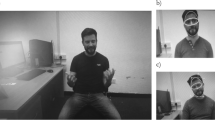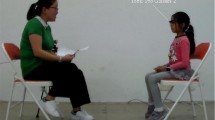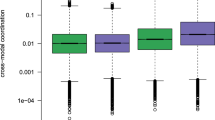Abstract
This study investigated the oculomotor performance in children with autism spectrum disorder (ASD) during a face-to-face conversation. A head mounted eye tracker recorded the eye movements in 20 children with ASD and 23 children with typical development (TD). Group comparisons were conducted on the randomness and the quantity of eye movement. The amount of time needed to reveal group difference was also examined. Results showed that the randomness of eye movement was significantly higher at all examined time durations, and the amount of eye movement was significantly greater within 3 s in the ASD group. These findings demonstrated an atypical pattern of oculomotor dynamics in children ASD, which might facilitate the objective identification of ASD during daily social interaction.






Similar content being viewed by others
Change history
05 October 2021
A Correction to this paper has been published: https://doi.org/10.1007/s10803-021-05294-0
Abbreviations
- ASD:
-
Autism spectrum disorder
- DSM-V:
-
The Diagnostic and Statistical Manual of Mental Disorders—5th Edition
- TD:
-
Typical development
References
Alviar, C., Dale, R., Dewitt, A., & Kello, C. T. (2020). Multimodal coordination of sound and movement in music and speech. Discourse Processes: A Multidisciplinary Journal. https://doi.org/10.1080/0163853X.2020.1768500
Benson, V., Piper, J., & Fletcher-Watson, S. (2009). Atypical saccadic scanning in autistic spectrum disorder—ScienceDirect. Neuropsychologia, 47(4), 1178–1182.
Chita-Tegmark, M. (2016). Social attention in ASD: a review and meta-analysis of eye-tracking studies. Research in Developmental Disabilities, 48, 79–93. https://doi.org/10.1016/j.ridd.2015.10.011
Clausius, R. (1867). The mechanical theory of heat: With its applications to the steam engine and to physical properties of bodies. London: John van Voorst.
Doherty-Sneddon, G., Bruce, V., Bonner, L., Longbotham, S., & Doyle, C. (2002). Development of gaze aversion as disengagement from visual information. Developmental Psychology, 38(3), 438–445. https://doi.org/10.1037/0012-1649.38.3.438
Dufour, M.-M., & Lanovaz, M. J. (2020). Increasing compliance with wearing a medical device in children with autism. Journal of Applied Behavior Analysis, 53(2), 1089–1096. https://doi.org/10.1002/jaba.628
Falck-Ytter, T. (2015). Gaze performance during face-to-face communication: a live eye tracking study of typical children and children with autism. Research in Autism Spectrum Disorders, 17, 78–85. https://doi.org/10.1016/j.rasd.2015.06.007
Falck-Ytter, T., Carlstrom, C., & Johansson, M. (2015). Eye contact modulates cognitive processing differently in children with autism. Child Development, 86(1), 37–47. https://doi.org/10.1111/cdev.12273
Fournier, K. A., Amano, S., Radonovich, K. J., Bleser, T. M., & Hass, C. J. (2014). Decreased dynamical complexity during quiet stance in children with autism spectrum disorders. Gait and Posture, 39(1), 420–423. https://doi.org/10.1016/j.gaitpost.2013.08.016
Frazier, T. W., Strauss, M., Klingemier, E. W., Zetzer, E. E., Hardan, A. Y., Eng, C., & Youngstrom, E. A. (2017). A meta-analysis of gaze differences to social and nonsocial information between individuals with and without autism. Journal of the American Academy of Child and Adolescent Psychiatry, 56(7), 546–555. https://doi.org/10.1016/j.jaac.2017.05.005
Freeth, M., Foulsham, T., & Kingstone, A. (2013). What affects social attention? Social presence, eye contact and autistic traits. PLoS ONE. https://doi.org/10.1371/journal.pone.0053286
Glenberg, A. M., Schroeder, J. L., & Robertson, D. A. (1998). Averting the gaze disengages the environment and facilitates remembering. Memory and Cognition, 26(4), 651–658.
Gliga, T., Bedford, R., Charman, T., & Johnson, M. (2015). Enhanced visual search in infancy predicts emerging autism symptoms. Current Biology, 25(13), 1727–1730.
Grinter, E. J., Maybery, M. T., Beek, P. L. V., Pellicano, E., Badcock, J. C., & Badcock, D. R. (2009). Global visual processing and self-rated autistic-like traits. Journal of Autism and Developmental Disorders, 39(9), 1278–1290.
Harrop, C., Jones, D., Zheng, S., Nowell, S. W., Boyd, B. A., & Sasson, N. (2018). Sex differences in social attention in autism spectrum disorder. Autism Research: Official Journal of the International Society for Autism Research, 11(9), 1264–1275. https://doi.org/10.1002/aur.1997
Hutchins, T. L., & Brien, A. (2016). Conversational topic moderates social attention in autism spectrum disorder: talking about emotions is like driving in a snowstorm. Research in Autism Spectrum Disorders, 26, 99–110. https://doi.org/10.1016/j.rasd.2016.03.006
Johnson, B. P., Lum, J. A., Rinehart, N. J., & Fielding, J. (2016). Ocular motor disturbances in autism spectrum disorders: systematic review and comprehensive meta-analysis. Neuroscience and Biobehavioral Reviews, 69, 260–279. https://doi.org/10.1016/j.neubiorev.2016.08.007
Jones, R. M., Southerland, A., Hamo, A., Carberry, C., Bridges, C., Nay, S., Stubbs, E., Komarow, E., Washington, C., Rehg, J. M., Lord, C., & Rozga, A. (2017). Increased eye contact during conversation compared to play in children with autism. Journal of Autism and Developmental Disorders, 47(3), 607–614. https://doi.org/10.1007/s10803-016-2981-4
Kanner, L. (1943). Autistic disturbances of affective contact. Nervous Child, 2, 217–250.
Kemner, C., Verbaten, M. N., Cuperus, J. M., Camfferman, G., & van Engeland, H. (1998). Abnormal saccadic eye movements in autistic children. Journal of Autism and Developmental Disorders, 28(1), 61–67. https://doi.org/10.1023/A:1026015120128
Klin, A., Jones, W., Schultz, R., Volkmar, F., & Cohen, D. (2002). Visual fixation patterns during viewing of naturalistic social situations as predictors of social competence in individuals with autism. Archives of General Psychiatry, 59(9), 809–816.
Klin, A., Lin, D. J., Gorrindo, P., Ramsay, G., & Jones, W. (2009). Two-year-olds with autism orient to non-social contingencies rather than biological motion. Nature, 459(7244), 257–261. https://doi.org/10.1038/nature07868
Kolmogorov, A. N. (1959). Entropy per unit time as a metric invariant of automorphism. Doklady Akademii Nauk SSSR, 124(4), 754–755.
Kovarski, K., Siwiaszczyk, M., Malvy, J., Batty, M., & Latinus, M. (2019). Faster eye movements in children with autism spectrum disorder. Autism Research, 12(2), 212–224. https://doi.org/10.1002/aur.2054
Möricke, E., Buitelaar, J. K., & Rommelse, N. N. J. (2016). Do we need multiple informants when assessing autistic traits? The degree of report bias on offspring, self, and spouse ratings. Journal of Autism and Developmental Disorders. https://doi.org/10.1007/s10803-015-2562-y
Melinger, A., & Levelt, W. J. M. (2005). Gesture and the communicative intention of the speaker. Gesture, 4(2), 119–141.
Miller, M., Chukoskie, L., Zinni, M., Townsend, J., & Trauner, D. (2014). Dyspraxia, motor function and visual–motor integration in autism. Behavioural Brain Research, 269, 95–102. https://doi.org/10.1016/j.bbr.2014.04.011
Murias, M., Major, S., Davlantis, K., Franz, L., Harris, A., Rardin, B., Sabatos-DeVito, M., & Dawson, G. (2018). Validation of eye-tracking measures of social attention as a potential biomarker for autism clinical trials. Autism Research, 11(1), 166–174. https://doi.org/10.1002/aur.1894
Nackaerts, E., Wagemans, J., Helsen, W., Swinnen, S. P., Wenderoth, N., & Alaerts, K. (2012). Recognizing biological motion and emotions from point-light displays in autism spectrum disorders. PLoS ONE, 7(9), e44473. https://doi.org/10.1371/journal.pone.0044473
Nadig, A., Lee, I., Singh, L., Bosshart, K., & Ozonoff, S. (2010). How does the topic of conversation affect verbal exchange and eye gaze? A comparison between typical development and high-functioning autism. Neuropsychologia, 48(9), 2730–2739. https://doi.org/10.1016/j.neuropsychologia.2010.05.020
Nowinski, C. V., Minshew, N. J., Luna, B., Takarae, Y., & Sweeney, J. A. (2005). Oculomotor studies of cerebellar function in autism. Psychiatry Research, 137(1–2), 11–19. https://doi.org/10.1016/j.psychres.2005.07.005
Pönkänen, L. M., Alhoniemi, A., Leppänen, J. M., & Hietanen, J. K. (2011). Does it make a difference if I have an eye contact with you or with your picture? An ERP study. Social Cognitive and Affective Neuroscience. https://doi.org/10.1093/scan/nsq068
Ramseyer, F., & Tschacher, W. (2011). Nonverbal synchrony in psychotherapy: coordinated body movement reflects relationship quality and outcome. Journal of Consulting and Clinical Psychology, 79(3), 284–295. https://doi.org/10.1037/a0023419
Sasson, N. J., Pinkham, A. E., Weittenhiller, L. P., Faso, D. J., & Simpson, C. (2016). Context effects on facial affect recognition in schizophrenia and autism: behavioral and eye-tracking evidence. Schizophrenia Bulletin, 42(3), 675–683. https://doi.org/10.1093/schbul/sbv176
Schmitt, L. M., Cook, E. H., Sweeney, J. A., & Mosconi, M. W. (2014). Saccadic eye movement abnormalities in autism spectrum disorder indicate dysfunctions in cerebellum and brainstem. Molecular Autism, 5(1), 47. https://doi.org/10.1186/2040-2392-5-47
Shannon, C. E. (1948). A mathematical theory of communication. Bell System Technical Journal, 5(3), 3–55.
Sumner, E., Hutton, S. B., & Hill, E. L. (2020). Subtle oculomotor difficulties and their relation to motor skill in children with autism spectrum disorder. Advances in Neurodevelopmental Disorders, 5, 1–12.
Tebartz van Elst, L., Pick, M., Biscaldi, M., Fangmeier, T., & Riedel, A. (2013). High-functioning autism spectrum disorder as a basic disorder in adult psychiatry and psychotherapy: psychopathological presentation, clinical relevance and therapeutic concepts. European Archives of Psychiatry and Clinical Neuroscience, 263(2), 189–196. https://doi.org/10.1007/s00406-013-0459-3
Wang, Q., Hoi, S. P., Wang, Y., Song, C., & Yi, L. (2020). Out of mind, out of sight? Investigating abnormal face scanning in autism spectrum disorder using gaze-contingent paradigm. Developmental Science. https://doi.org/10.1111/desc.12856
Wang, Q., Hu, Y., Shi, D., Zhang, Y., Zou, X., Li, S., Fang, F., & Yi, L. (2018). Children with autism spectrum disorder prefer looking at repetitive movements in a preferential looking paradigm. Journal of Autism and Developmental Disorders, 48(8), 2821–2831. https://doi.org/10.1007/s10803-018-3546-5
Wass, S. V., Jones, E. J. H., Gliga, T., Smith, T. J., Charman, T., Johnson, M. H., & BASIS Team. (2015). Shorter spontaneous fixation durations in infants with later emerging autism. Scientific Reports, 5(1), 8284. https://doi.org/10.1038/srep08284
Zhao, Z., Tang, H., Zhang, X., Zhu, Z., Xing, J., Li, W., Tao, D., Qu, X., & Lu, J. (2021a). Characteristics of visual fixation in Chinese children with autism during face-to-face conversations. Journal of Autism and Developmental Disorders. https://doi.org/10.1007/s10803-021-04985-y
Zhao, Z., Zhu, Z., Zhang, X., Tang, H., Xing, J., Hu, X., Lu, J., Peng, Q., & Qu, X. (2021b). Atypical head movement during face-to-face interaction in children with autism spectrum disorder. Autism Research. https://doi.org/10.1002/aur.2478
Funding
The study was financially supported by the National Natural Science Foundation of China (No. 82171539), the SZU Funding Project (No. 860-000002110259), the Science and Technology Innovation Committee of Shenzhen (No. JCYJ20190808115205498), the Key Medical Discipline of Guangming Shenzhen (No. 12 Epidemiology), Sanming Project of Medicine in Shenzhen (No. SZSM201612079), Key Realm R&D Program of Guangdong Province (No. 2019B030335001), Shenzhen Key Medical Discipline Construction Fund (No.SZXK042), and Shenzhen Double Chain Grant [2018]256.
Author information
Authors and Affiliations
Contributions
Author contributions
ZZ, XZ, XQ, and JL designed the experiment and recruited participants. ZZ, JX, and XH performed data analysis and statistics. ZZ, XZ, and XQ drafted and revised the manuscript.
Corresponding authors
Ethics declarations
Conflict of interest
None of the authors declare a financial interest in any of the products or devices mentioned in the manuscript.
Additional information
Publisher's Note
Springer Nature remains neutral with regard to jurisdictional claims in published maps and institutional affiliations.
Appendix: Details of the Structured Conversation: Generic Question
Appendix: Details of the Structured Conversation: Generic Question
1. What is your name |
2. How is your name written |
3. What is the name of your school and what grade are you in? |
4. Who is your best friend? What is your favorite thing to do together? |
5. Could you please share with me the most interesting thing happened last week? Let me know the time, place, people and the whole process of the event |
6. What is the plan for your summer vacation? |
Rights and permissions
About this article
Cite this article
Zhao, Z., Xing, J., Zhang, X. et al. Random and Short-Term Excessive Eye Movement in Children with Autism During Face-to-Face Conversation. J Autism Dev Disord 52, 3699–3710 (2022). https://doi.org/10.1007/s10803-021-05255-7
Accepted:
Published:
Issue Date:
DOI: https://doi.org/10.1007/s10803-021-05255-7




